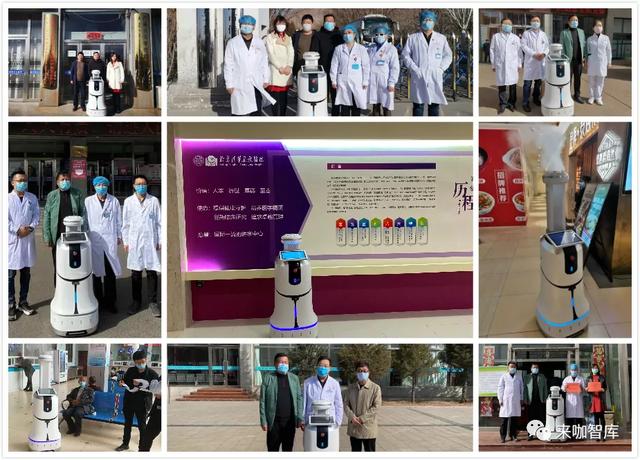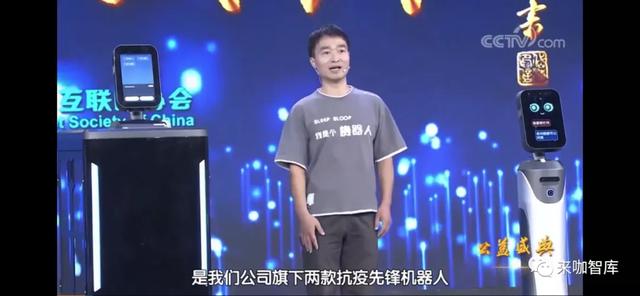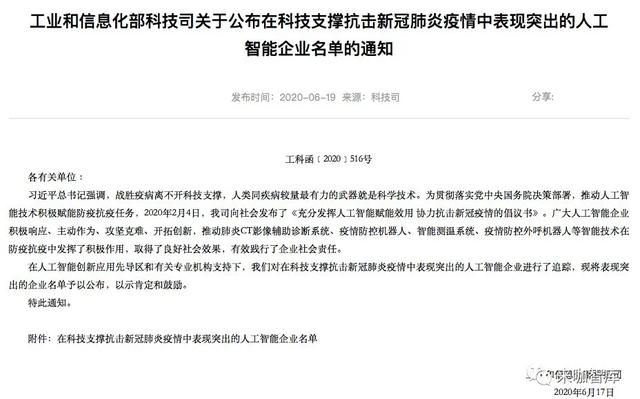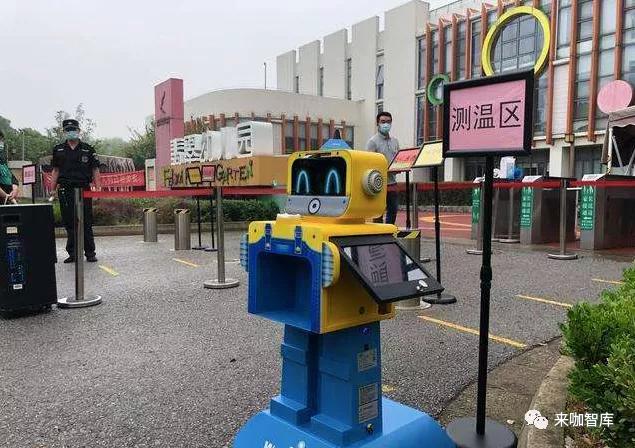文 | 丰远
When the seas are in turmoil, heroes are on their mettle.
This year’s outbreak of the epidemic has lasted for nearly 7 months. In addition to the "retrograde" composed of thousands of medical workers, police, and volunteers, intelligent robots with their own characteristics have also become the nation's anti-epidemic battle "Special forces" in China. The application of intelligent robots in all aspects of epidemic prevention and control has greatly reduced the workload of "retrogrades", improved work efficiency, and won time and space for this epidemic prevention and control.
The China Artificial Intelligence Industry Development Alliance’s latest "Artificial Intelligence Helps New Crown Epidemic Prevention and Control Research Report" released this year shows that among more than 500 artificial intelligence anti-epidemic products, intelligent service robots, big data analysis systems, and intelligent identification (temperature measurement) products. It is the most used artificial intelligence product in epidemic prevention and control. Among the intelligent service robot products with the highest number of products, intelligent outbound robots and intelligent service robots (physical) in medical scenarios have the highest application volume.
In fact, it is not uncommon for robots to be used in epidemic prevention and control, especially service robots, which have attracted much attention in their applications in the medical field. Beside of hospitals, various robots have also staged "front line support", "fancy" assists in epidemic prevention work in various regions and industries. So in the current situation of normal epidemic prevention and control, can intelligent robots replace humans as an effective means of prevention and control? What needs to be improved? Will the industry usher in a flashpoint in the future? This also deserves further attention from the further part of the world.
Intelligent robots become "anti-epidemic special forces"
One-stop inspection, distribution, temperature measurement and elimination
Artificial intelligence officially joins the team in the fight against the epidemic, starting with an encouragement policy.
Due to the shortage of medical staff and the high risk of cross-infection of the epidemic, on February 4 this year, the Ministry of Industry and Information Technology of the People's Republic of China issued the "Proposal for Giving Full Play to the Power of Artificial Intelligence to Combat the Pneumonia Epidemic Caused by the Novel Coronavirus Infection", encouraging the use of AI to fight the epidemic Enabling, advocating the joint research of national artificial intelligence enterprises, application units, and upstream and downstream related enterprises, using AI technology as soon as possible to fill up the shortcomings of epidemic management and control technology, and fully exploring the application scenarios of artificial intelligence service robots in the diagnosis and treatment of new pneumonia and epidemic prevention and control.
Since then, major technology companies and AI technologies and products of various levels and applications have begun to appear on the front line of epidemic prevention and control in the form of "contactless devices" and "intelligent labors", becoming "special forces fighting against epidemic."
On the front line of the anti-epidemic, key tasks such as delivery of medicines and meals, disinfection and cleaning, diagnosis and treatment assistance, and security protection that were previously required by medical personnel can now be replaced by auxiliary and service robots. Technology companies have rapidly developed and invested in disinfection and temperature measurement. Various types of robots, such as medical guidance, publicity, patrol control, outbound calls, remote auxiliary diagnosis, throat swab sampling, transmission or logistics, and even cooking, effectively block the "chain of virus transmission from person to person."
For example, in terms of temperature measurement and disinfection, in the early stage of the domestic epidemic, iBen Intelligent made full use of the company's accumulation of software and hardware technology, and responded quickly. The iBen Intelligent disinfection robot was launched as soon as possible for public places such as hospitals, subway stations, and railway stations, provides various disinfection modes such as temperature measurement, ultra-dry atomization disinfection, and ultraviolet lamp disinfection. In the case of mass production in March this year, with accurate temperature measurement, 360° high-efficiency disinfection mode without dead ends, and disinfection efficiency in complex scenarios, iBen Intelligent disinfection robots have been applied to Wuhan, Beijing, Inner Mongolia, More than 20 provinces and cities including Sichuan and Guizhou, covering hundreds of hospitals, shopping malls and other public places across the country.

iBen Intelligent Disinfection Robot
According to Zhang Dawei, vice president of marketing at iBen Intelligent, due to the national shutdown and production in the early stage of the epidemic, transportation was basically paralyzed. All R&D and technical personnel of the company can only act remote working and work at least 20 hours a day; product testing is also required for hardware. In order to be able to return to work as scheduled to participate in the software and hardware debugging, some employees walked over the mountain for 5 kilometers before embarking on the way back to Beijing; the employees of the intelligent manufacturing base, in the case of poor accommodation and food shortage, also work overtime, the production task was overfulfilled, the construction period was finally guaranteed, and the smooth delivery was realized.
In terms of epidemic propaganda and diagnosis, iFLYTEK also opened iFLYTEK’s dubbing and virtual anchor technology to provide epidemic prevention and control propaganda services to media and administrative units. During the epidemic, the virtual anchor provided free epidemic prevention and control propaganda to more than 150 media Broadcasting, iFLYTEK’s dubbing has provided users with more than 4,000 prevention and control propaganda voices for free, serving all townships and propaganda units. At the same time, in order to reduce the risk of medical staff’s door-to-door communication, iFLYTEK also uses intelligent medical assistant phone robots to support the screening, prevention and control, and education of key populations during the epidemic. 30 companies in Anhui, Beijing, Zhejiang, Jilin, Hubei, etc. Provincial, municipal and regional health committees and grassroots doctors make full use of smart medical assistant phone robots to call and send text messages to residents, inform the prevention and control knowledge related to new coronary pneumonia, and follow up key populations. From January 21st to May 24th, intelligent medical assistant phone robots have served a total of 58.09 million people during epidemic education and follow-up visits to key populations.

IFLYTEK's virtual anchor broadcasts the epidemic
In terms of distribution and logistics, the food delivery robot "Happy Delivery" developed by Pudu Technology replaces medical staff to deliver meals, medicines and other items, reduces the shortage of manpower and realizes contact-free delivery. It is currently in Guangdong, Zhejiang, and Beijing. More than 100 hospitals and isolation points in other places provided services; the peanut food delivery robot of Keenon Technology was invested in more than 10 provinces and cities including Hubei, Guangdong, Zhejiang, Henan, and Hunan in the early stage of the epidemic, involving nearly 50 hospitals and isolation points, responsible for the distribution of meals, daily necessities, medical supplies, etc. For long-distance logistics and transportation, JD’s unmanned delivery vehicle "Dabai" has a design speed of 30 km/h, which can automatically slow down, avoid obstacles, and identify traffic lights. After participating in the fight against the epidemic for more than 100 days, "Dabai" is the city of Wuhan. The number of material packages delivered by the Ninth Hospital reached 13,000.
In addition to the above-mentioned anti-epidemic robots for specific scenarios, there are also some technology companies that provide systematic multi-scenario solutions. After the epidemic prevention and control battle started, Orion Star and Cheetah Mobile donated the intelligent epidemic cooperation service robot Leopard secretary and the intelligent delivery service robot Leopard courier to front-line hospitals such as Wuhan Huoshenshan Hospital and Beijing Haidian Hospital for the first time. Infrared temperature measurement version of medical robots, epidemic prevention and control outbound robots, etc. are launched to support the fight against the epidemic with practical actions and help hospitals and medical staff to win the battle of epidemic prevention and control.

Leopard courier and Leopard secretary of Orion Star participated in the China Internet Conference Charity Ceremony
And UBIC has also launched three intelligent anti-epidemic robots during the epidemic: indoor temperature measurement and inspection robot AIMBOT (intelligent inspector), outdoor intelligent anti-epidemic robot ATRIS (safety inspector) and medical consultation robot Cruzr The three robots cover the hygiene and epidemic prevention scenarios of indoor body temperature monitoring and elimination, outdoor epidemic control and elimination, and publicity and diagnosis. According to official data, compared with handheld temperature measurement, AIMBOT robot temperature measurement can save 64% of labor costs per day, reduce the workload of a single person by 80%, and increase the detection efficiency from 3 persons/minute to 22 persons/minute, which is a huge Alleviated the manpower shortage faced by the central hospital. In addition, Dart Technology's 5G intelligent robots are used in complex scenarios in hospitals to replace medical staff to complete remote care, temperature measurement, disinfection, cleaning, and medicine delivery, and reduce cross-infection of personnel.
In addition to showing their skills in anti-epidemic efforts in various parts of the country, intelligent robots have also begun to be sold to overseas markets and participated in global anti-epidemic actions when the epidemic situation in foreign countries intensified.
According to incomplete statistics, Chinese technology such as iBen Intelligent, Jifei Technology, Aike Robot, Orion Star, CSG Huaxiao, Songling Robot, Titanium Robot, Youai Zhihe, Keenon Intelligent, and Jingzhi Hi-Tech The company has sold disinfection robots, inspection robots, food delivery robots and other products to overseas countries and regions with severe epidemics, including Europe (Italy, Spain, Germany, France, Austria), the United States, and Asia (Japan, South Korea, Singapore) , Thailand, Malaysia), the Middle East (Saudi Arabia, UAE, Qatar, etc.), etc., used for disinfecting work in densely populated or public places such as local governments, hospitals, communities, shopping malls, factories, stations, etc.
The national level also affirmed the response speed and positive performance of these technology companies. In June of this year, the Ministry of Industry and Information Technology announced the list of "Artificial Intelligence Companies with Outstanding Performance in the Fight Against the New Coronary Pneumonia Epidemic Supported by Technology". A total of 79 companies or institutions were selected, of which 18 were companies related to epidemic prevention and control robots.

The relevant person in charge of Orion Star said that in this epidemic prevention and control battle, Cheetah Mobile and Orion Star gave full play to the empowering effect of artificial intelligence, assisted all parties in fighting the epidemic, and supported the victory of this battle. The connection between good technology and applications allows hard-core products and services to quickly play a role in social public incidents and emergencies, and adopt useful and easy-to-use "tools" to quickly solve problems; in the future, more AI technologies, Robots and big data services are invested in public services and family services, so that the intelligent and digital upgrades of public services and life services can help more people, become reliable infrastructure in life, help the further development of the real economy, and build for the society more solid technical guarantee.
"This epidemic has made more people feel the value of robots to society more intuitively, and the originally' slow heating' market has begun to heat up." According to Cheng Haotian, CEO of Gaissian Robotics, robots have been widely used in industrial fields before. Intelligent robots that have been on the front line this time have participated in different links in the fight against the epidemic and have gained more market recognition. It not only awakens the market with facts and makes people realize the value of AI empowerment, it is also the fuse for the next round of industrial upgrading and technological innovation, and enterprises see more development opportunities from it.
Under normal epidemic prevention and control
Opportunities and challenges of robots
The outbreak of the epidemic has provided the robot industry with an excellent training opportunity, and has also made all walks of life realize the commercial value and service value of service robots in the industry, and gradually integrate them into people's daily work and life. In the current and later period of normalized epidemic prevention and control, will robots become a new outbreak point? What are the challenges?
In May of this year, the State Council issued the "Guiding Opinions on Doing a Good Job in the Normalization of the Prevention and Control of the New Coronary Pneumonia Epidemic", focusing on five major aspects: focusing on prevention, implementing the "four early" measures, highlighting key links, strengthening support and guarantees, and strengthening organization and leadership. 20 key measures have been introduced to deploy and strengthen normalized prevention and control work, and the key links include key places, key institutions, key populations, medical institutions, campuses, and community prevention and control.
For example, for key populations and campuses and other places, the intelligent morning check robot can realize auxiliary morning check, epidemic screening, upload information at any time, and collect data at a faster rate. It can realize the need for rapid body temperature measurement during the epidemic period and keep body temperature data. All body temperature data of all staff are kept, and the data records can be viewed in real time in the background, which is convenient for historical traceability. The emergence of such intelligent morning inspection robots has solved almost all the problems under manual operation and helped campuses respond to epidemic prevention requirements.

Intelligent morning check robot
Zhang Dawei said that under the current normal epidemic prevention and control, intelligent robots can basically meet customers' temperature measurement and disinfection. Take iBen intelligent disinfection robot as an example. In terms of temperature measurement, it uses leading infrared dual-light temperature measurement equipment, which can achieve long-distance non-sensing temperature measurement of 0.8-4 meters, with an accuracy of ±0.3°C, and human body temperature is too high. , Automatic voice alarm, face photos and corresponding body temperature data are retained, and simultaneously supports external screen data display. In railway stations, airports, hospitals and other places with high passenger flow, fast passage can be achieved, and generally there will be no stranded conditions.
In terms of disinfection, as long as there is sufficient disinfectant in the storage tank and the time is set, the iBen intelligent robot can plan its own path and walk while avoiding obstacles for intelligent disinfection under the condition without any manual operating. In the case of insufficient power, the robot can self-returning to the pile for charging can achieve separation of man and machine, effectively liberating labor and avoiding cross-infection.
At present, the Orion star intelligent service robot has also been successfully implemented in more than 20 industries such as rail transit, medical institutions, large shopping malls, KTV, conventions and exhibitions, communications, tourism, museums, libraries, schools, and government affairs halls, providing smart guides and smart services such as shopping guide, smart government affairs, and smart conference affairs. Products such as intelligent delivery service robots and intelligent labor service robots have also achieved one-stop deep customization. As of May 2020, the total number of service personnel has exceeded 200 million, the average daily voice interaction frequency has exceeded 5 million, and more than 10,000 robots are on duty with more than 1,600 customers.
According to relevant data, domestic service robot market is entering a period of rapid growth, with huge market demand potential. It is estimated that by 2021, with the rapid development of application robots in emerging scenarios such as medical service robots and retail service robots, the scale of my country's service robot market is expected More than 4 billion U.S. dollars. McKinsey Consulting also listed robots in 12 disruptive technologies that will affect the future, and predicts that by 2025, the application of advanced robots in manufacturing, medical, and service industries can create an output value of US$1.7 trillion to US$4.5 trillion.

Which service robots will be favored in the future? According to Lars Reneke, a German economist, there are mainly the following: disinfection robots that can help disinfect public places such as hospitals and reduce personnel risks, and laboratory robots that can help scientific researchers complete dangerous operations. Housework also facilitates remote monitoring by relatives, friends and doctors to take care of the elderly robots, parking robots that help drivers park and prepare vehicles in advance, robots that transport food and medicine, and robots that provide information in public places.
Regarding the development of the robotics industry, Lars Reneck believes that China has more advantages in the field of service robots: First, China has comprehensive advantages in artificial intelligence, 5G, and big data, which can improve the intelligent voice and image of robots. Recognition, algorithms and other technologies drive more scene-based applications. Second, China has advantages in the industrial chain, from upstream raw materials, to an active global R&D system, and to facing the world's largest consumer group. In addition, Chinese companies have advantages such as sufficient funds. These are not available to robot manufacturers in Europe, America and Japan. Of course, Chinese companies should also cooperate with global leaders to enhance their overall strength.
In an interview, Zhang Dawei also pointed out that looking at the world, disinfection robots are still a new topic in the field of intelligent robots, and there is no particularly authoritative industry standard as of now. However, the outbreak of the epidemic in China was early, and AI technology companies responded in a timely manner. Both R&D and production are almost at the forefront of the world.
Fu Sheng, chairman of Orion Star, once said in an interview that the robotics industry will become very large in ten years. We put forward the concept of "really useful", hoping that robots can really come in handy, not just cool showing at the exhibition. After showing one or two times, there will be no more further. "But making robots is not easy. At present, the entire robotics industry is at an early stage of development. When artificial intelligence companies make robots, there is no mature technical model and business model to refer to."
At the same time, the "Artificial Intelligence Helps New Crown Epidemic Prevention and Control Research Report" report also pointed out that there are still some weak links in the current application of artificial intelligence, including insufficient data accumulation, mixed product quality, and intelligence. There is still room for improvement. The accumulation of basic technology and the insufficient ability to deal with complex scenarios are still far from the service robots that people expect to be able to perform general and complex tasks.
Zhang Dawei said that although the first-generation products of iBen Intelligent can meet most of the scenes, they still have some shortcomings in some special scenes. Under user feedback and testing and experimentation by test engineers over and over again, the intelligent disinfection robot team continues to study the use characteristics of other scenarios and the matching degree of hardware, and continues to optimize and iterate the software and hardware of the product. The new series of disinfection robot products almost cover All usage scenarios can easily perform disinfection work in some special scenarios.
It can be said that the sudden epidemic has boosted the intelligent development and application of the medical industry. On the one hand, the new opportunities brought by hospitals face the escalating demand for sensory control. Advanced modes such as intelligent disinfection and contactless delivery will gradually become the new normal of hospital management. The disinfection and protection of intelligent disinfection robots can be combined into one. greatly improve the safety factor; on the other hand, it brings challenges, such as how to deepen the application of robotics and artificial intelligence technology, and improve the stability and reliability of the application, so that related technologies can replace medical personnel in certain high-risk scenarios and reduce medical affairs. The risk of personnel, this also requires continuous exploration.






